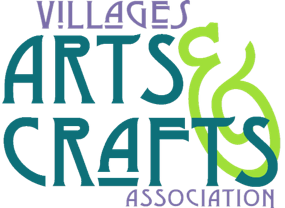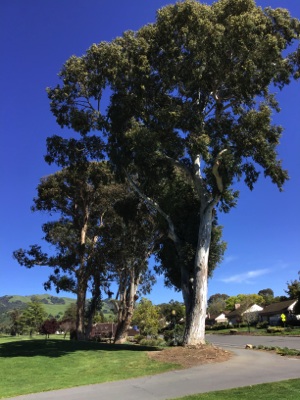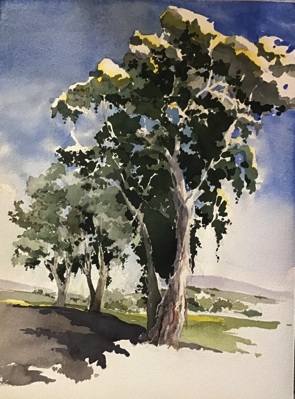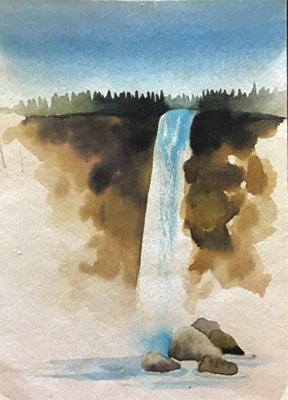
Try an Artistic Shelter-in-Place Challenge
by Ciel Duke (first article)
Now is the perfect time to hone your art skills! During these shelter-in-place weeks, there are three outstanding reasons that make it just about impossible to find an excuse to avoid daily practice…
1. You have plenty of time on your hands.
2. We're being told it's important to keep busy, have a schedule, and set goals.
3. You couldn't live in a more beautiful setting, providing a limitless array of suitable subject matter. (Shout out to our wonderful landscaping staff!)
Since all art requires good drawing skills, let's get started with a daily drawing regimen. If possible, find a place where you don't have to set up and take down your supplies with each session. To begin, try 15 to 30 minutes a day by making a pencil study in a sketchbook or on computer paper of simple, everyday objects – a cup and saucer, a watering can, a lamp or favorite chair. Concentrate on proportion initially, then study the light source and add shading to create realism.
After gaining confidence with these simple subjects, you can try using a charcoal pencil (or even a briquette), adding character to your drawings by blending with a cotton ball or Q-tip as you move on to more complex subjects – a flower or plant, a simple still life of three objects different in size, shape and texture, or a tree beside a pathway, for instance. Here's an important thing to remember … subjects vary greatly in their degree of difficulty. Choose a subject that affords you the opportunity for success, such as a tree. You just can't mess up a tree, since they come in all shapes and sizes! Contrast that to drawing animals or people, both of which are quite unforgiving subjects. Be patient ... you will get there!
After training your eye to see value, details, and proportion, it might be time to move on to using color - such as colored pencils, watercolor pencils, pastels, watercolor, or acrylics. All these materials are readily available online – delivered right to your door!
Indeed, drawing daily is a significant challenge, but I guarantee you….it is worth it! I have often emphasized in my classes that you are your best teacher! And …wouldn't it be nice to end up with improved art skills along with an impressive portfolio of wonderful art!
“Great art picks up where nature ends.” Marc Chagall
Published in The Villager on April 16, 2020
Plain Talk about Plein Air (2nd article)
by Ciel Duke
Drawing and painting 'en plein aire', or 'in the open air', is currently at a peak of exposure and success. In the past 15 years, an explosion of plein air exhibits, galleries, conventions and competitions has caught the attention of thousands of artists willing to brave the elements and venture out into nature in order to capture light, shadow, color and mood in a way that studio painting or painting from a photograph is unable to do.
Plein Air painting goes back to the late 1500s in Russia. The movement gained widespread popularity in Europe with the Impressionists, notably Monet, Seurat, and Degas. Their fascination with capturing the fleeting impression of light and mood in nature opened up an entire new approach to painting, eschewing centuries of predictable religious, allegorical, and still life subjects. In America, Winslow Homer painted en plein aire even before that with a series of front-line Civil War paintings for Harper's Bazaar. The Hudson River School and Canada's Group of Seven continued plein air painting in the mid-19th century.
The Villages offers an ideal location to experiment... with beautiful vistas in every direction (try looking out from either garden site), waterfalls and lakes, bountiful flower beds and shrubs, footpaths and canyon views, trees of every kind, stunning sunsets. No doubt, Villagers who have taken advantage of this shelter-in-place time by walking throughout our many paths, have discovered scenery they never knew existed!
So.....let's get started with Plein Air painting! Assuming you have found the 'perfect spot', imagine yourself out-of-doors and actually painting. You will need a chair, a small table or box to set supplies on, sunscreen and water, and comfortable clothing. Choose any medium you are familiar with. Watercolors require less equipment- a watercolor set, brushes, watercolor paper mounted on a firm surface, and, of course, water. Oils and acrylics require an easel, tube paints and palette, brushes, painting surface, and a means to carry wet paintings. Keep equipment to a minimum, as you might need to walk a distance to set up. Choose a safe location, away from traffic or distractions. Remember, these paintings are to be completed ON LOCATION, with perhaps only a small touch up back in the studio. Be patient....the process gets easier with each outing!
Over time, you will discover that plein air drawing and painting somehow mysteriously imbues your art with the 'essence'...the mood of your subject. With experience, you will convey the wind, the heat of the sun, the cold crispness of winter, or even the reason why you chose this exact spot to paint. Give it a try....you have the time, the perfect place, and the inspiration- all right here in the Villages!
NOTE: As a longtime plein air painter, Ciel Duke can be seen here and there working on a plein air watercolor series of the Trees of the Villages. She appreciates the gift it gives the heart, the challenge it gives the brain, and the enthusiasm to see and experience life itself.
To illustrate painting plein air, Ciel took this photo of what she painted outside. The painting was done outside, not in her studio.
Published in The Villager on May 7, 2020


Artistic License - in Art & Everyday Life
3rd article by Ciel Duke
Artistic License is a handy and critical license to own...and it’s free, since it’s self-granted! No appointments needed, no online registration, no long lines, no exams- what could be easier?
Let’s talk about Art first. There are two aspects to using Artistic License in art.....changing and editing. In the Waterfall watercolor illustrated here, a cumulus cloud-filled sky was changed into a peaceful, overall blue sky. Why? Because this painting is about the WATERFALL, not the sky. There is no room in this small watercolor for visual competition. Secondly, the boulders in the foreground were 'moved' from their actual location on the far right of the waterfall to a more central position. Reason? For better composition and to draw the eye to the center of interest, the waterfall.
Regarding the Artistic License concept of editing, this painting underwent considerable ruthless edits. For example, there were distant mountains behind the trees. Why delete them? They would weaken the power of the eye-catching jagged line of treetops. Also, since this plein air location was a tourist lookout point, there were multiple safety warning signs, a garbage can, and a picnic table in view. Reason for editing them out? Again, this painting is about the WATERFALL, not these extraneous and irrelevant distractions. Incidentally, the artist has a real advantage over the photographer here, as the camera records it all. The artist with an Artistic License and an artistic eye might not want to!
In everyday life, how could the change/edit concepts of Artistic License apply? During these shelter-in-place months, many people have spoken about having a renewed appreciation for what truly matters. Articles and news clips talk about reducing our mindless consumerism and our devotion to filling every moment with activity. It might be time to pull out that Artistic License and consider life as Art. Are there situations that could be changed? Are there things that could be eliminated? Maybe even deleted altogether?
Published in The Villager on May 28, 2020

Art Insights by Ciel Duke